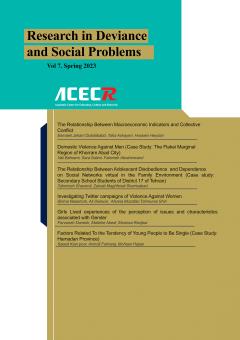-
-
-
Open Access Article
1 - Problems of Specialized Human Resources Educational and Occupational Challenges Narrated by The Ph.D. Graduated
Mohammad Tavakol Akhtar Shiri Saeed SemnanianThe aim of this research was to identify the challenges faced by the PhD graduates, specifically in the areas of work and occupation, as well as the related problems of their education, research, possibilities, and expectations during and after university study. The the MoreThe aim of this research was to identify the challenges faced by the PhD graduates, specifically in the areas of work and occupation, as well as the related problems of their education, research, possibilities, and expectations during and after university study. The theoretical approach in this research was Mertonian, and the statistical population consisted of those who graduated from 16 superior universities in Iran between 2014to2019. They were 16069 out of which 12434 were available through email and received our e-questionnaire. One of the important findings of this survey was that at the job market level the universities were the bigger consumer of PhD holders, employing them more than other sectors such as economic, industry and services. Moreover, female graduates in compare to male had fewer opportunities for employment (54% versus 79%). The respondents complained about salary and job privileges and expressed their inclination to immigrate to other countries (more than 70%). Manuscript profile -
Open Access Article
2 - Unemployment, Uneven Regional Development And Spatial Patterns of Internal Migration in Iran
Rasoul SadeghiInternal migration and movement occur in response to a wide range of factors with different effectiveness. One of the important and key contexts for the formation of internal migration is spatial inequality in facilities, opportunities and development components. In thi MoreInternal migration and movement occur in response to a wide range of factors with different effectiveness. One of the important and key contexts for the formation of internal migration is spatial inequality in facilities, opportunities and development components. In this regard, the article uses the secondary analysis of the 2016 census data at the provincial and county levels to investigate the impact of youth unemployment and unequal regional development on internal migration in Iran. The results showed the spatial clusters of unemployment and underdevelopment in the country and inequality in access to economic and social resources and opportunities on the one hand, and regional differences in migration rates, on the other hand. The highest level of development and the lowest unemployment rate of young people, as well as high immigration in the central regions of the country, especially the capital. In contrast, the western, northwestern, eastern and southeastern border regions have the lowest level of development and the highest unemployment and emigration rates. Therefore, internal migration is a dynamic, multidimensional process that arises from structural conditions and regional inequalities. Manuscript profile -
Open Access Article
3 - The Role of Inequalities in Migration from Iran's Border Counties
Valiollah Rostamalizadeh Reza NobakhtThe role of regional and spatial inequalities, especially the role of inequalities in the border areas of the country, has been given less attention in the issue of migration. Although Iran's border areas have strategic importance from economic, social, and political as MoreThe role of regional and spatial inequalities, especially the role of inequalities in the border areas of the country, has been given less attention in the issue of migration. Although Iran's border areas have strategic importance from economic, social, and political aspects, and Ignoring paying less attention to these areas can have irreparable consequences in various sectors. This research aims to investigate the situation of Iran's border regions in terms of spatial inequalities and what effect these inequalities have on migration from these regions. In order to measure the spatial inequality among the border counties, the data of the general population and housing census of 2016 and other related findings have been used. Factor analysis has been used to weight and combine indicators and create spatial inequality. Arc Pro software was used for zoning and stratification of counties based on the dimensions of inequality and migration, and GWR statistical method was used to analyze the relationship between inequality and migration. The results show that inequality is higher in the eastern and southeastern counties compared to other places. Also, 66% of Iran's border counties have a negative migration balance. The geographically weighted regression model shows that 67% of the changes in the net migration variable are explained by independent variables, and based on the average value presented, the population structure factor and the economic factor have the greatest effect on the net migration in border counties. Also, the effectiveness of factors for migration is different in different regions of the country. Manuscript profile
List of Articles مهاجرت
-
The rights to this website are owned by the Raimag Press Management System.
Copyright © 2017-2024

